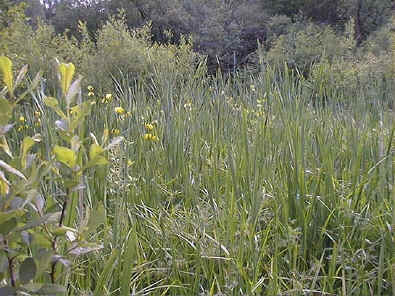Offwell Wetland Survey
Area B - Marsh Zone

In the marsh zone, the standing water levels vary across the area and the sediment is not permanently covered by water. Water levels rise and fall according to the amount of rainfall and run-off entering the wetland. In many places there is no standing water, although the underlying sediment is water-logged and anaerobic. In areas with standing water, the depth is rarely more than 10cm and usually as little as 1cm. This area supports a much greater variety of plant species (32) than the swamp area (17). However, there is a good deal of overlap of species between the two areas. Species characteristic of this area include Willow, Alder, Soft Rush, Yellow Iris, Branched Bur-reed, Greater Reedmace, Water Mint and Wood Clubrush amongst many others. Isolated local mounds of trapped sediment which raise the substrate above standing water levels are a feature of the area. These allow a few plants belonging to species normally characteristic of much drier areas to survive. (This includes species such as Bramble and Silver Birch.) The invertebrate animals inhabiting this area include a variety of spiders such as the Garden Spider (Araneus diadematus), many different hoverflies, wasps and ichneumon flies. Dragonflies such as Southern Hawkers (Aeschna cyanea) and the Golden-ringed Dragonfly (Cordulegaster boltonii) patrol the area and damselflies and snails are common. In the spring, toads and common frogs abound as they come to spawn in the open water and swamp areas of the wetlands. Grass snakes can often be observed and roe deer come to lie up in the day time. |
| Salicaceae | t |
| Salix caprea agg. | Goat Willow |
| Betulaceae | t |
| Alnus glutinosa (L.) Gaertn. | Alder |
| Betula pendula Roth | Silver Birch |
| Ranunculaceae | t |
| Ranunculus lingua L. | Greater Spearwort |
| Saxifragaceae | t |
| Chrysosplenium oppositifolium L. | Opposite-Leaved Golden Saxifrage |
| Rosaceae | t |
| Filipendula ulmaria (L.) Maxim. | Meadowsweet |
| Rubus fruticosus agg. | Bramble |
| Onagraceae | t |
| Circaea lutetiana L. | Enchanter's Nightshade |
| Epilobium palustre L. | Marsh Willowherb |
| Umbelliferae | t |
| Angelica sylvestris L. | Angelica |
| Oenanthe crocata L. | Hemlock Water Dropwort |
| Polygonaceae | t |
| Persicaria hydropiper (L.) Spach | Water-Pepper |
| Reynoutria japonica Houtt. | Japanese Knotweed |
| Rumex conglomeratus Murray | Clustered Dock |
| Callitrichaceae | t |
| Callitriche stagnalis Scop. | Common Water-Starwort |
| Menyanthaceae | t |
| Menyanthes trifoliata L. | Bogbean |
| Labiateae | t |
| Mentha aquatica L. | Water Mint |
| Rubiaceae | t |
| Galium palustre agg. | Marsh Bedstraw |
| Solanaceae | t |
| Solanum dulcamara L. | Bittersweet/Woody Nightshade |
| Scrophulariaceae | t |
| Scrophularia auriculata L. | Water Figwort |
| Compositae | t |
| Cirsium palustre (L.) Scop. | Marsh Thistle |
| Pulicularia dysenterica (L.) Bernh. | Fleabane |
| Alismataceae | t |
| Alisma plantago-aquatica L. | Water-plantain |
| Graminae | t |
| Glyceria fluitans (L.) R. Br. | Floating Sweet Grass |
| Juncaceae | t |
| Juncus effusus L. | Soft Rush |
| Juncus acutiflorus Ehrh. ex Hoffm. | Sharp-flowered Rush |
| Cyperaceae | t |
| Carex paniculata L. | Greater Tussock Sedge |
| Carex pendula Huds. | Pendulous Sedge |
| Scirpus sylvaticus L. | Wood Club-rush |
| Iridaceae | t |
| Iris pseudacorus L. | Yellow Iris |
| Lemnaceae | t |
| Lemna minor L. | Common Duckweed |
| Sparganiaceae | t |
| Sparganium erectum L. | Branched Bur-reed |
| Typhaceae | t |
| Typha latifolia L. | Greater Reedmace |
| Ferns | t |
| Athyrium felix-femina (L.) Roth. | Lady Fern |
| Mosses | t |
| Brachythecium rivulare B., S. & G. | |
| Dicranum scoparium Hedw. | |
| Eurhynchium praelongum (Hedw.)Br. Eur. | |
| Hypnum cupressiforme Hedw. | |
| Thuidium tamarascinum (Hedw.)B., S. & G |
| These species lists are not exhaustive. They represent initial collections and identifications carried out in early autumn. Many species of flowering plants may already have flowered and died back at this time and would therefore have been missed. These lists will be updated periodically. |
Back to
Areas page Complete
Survey Species List Back to Wetland diagram